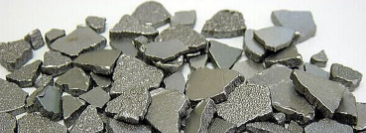High purity Iron flakes 99.99%
Complex electrochemical purification allows for the removal of
deleterious elements in order to achieve purity levels of up to 99.99%
(4N) iron.
Perhaps equally as important as purity is the high level of uniformity
that our Electrolytic Iron offers.
The electrolytic iron used in the experiment, high-purity iron,
imported, not industrial pure iron, not electrical pure iron,
It is very difficult to purify ordinary iron to 99.9. It is very
difficult to improve the purity, desulfurization, decarburization,
deoxidation, and other impurities. Ordinary electric arc furnaces or
vacuum furnaces can no longer meet the composition requirements.
High-purity iron produced by vacuum electrolysis of electric furnace
pure iron in an aqueous solution of iron sulfate for many times.
2 Production process editing The electric furnace pure iron is pre-made
into a thick plate as the anode, the pure iron is made into a thin sheet
as the cathode, and a mixture of high-purity sulfuric acid and ferrous
sulfate is used as the electrolyte. After energization, iron loses
electrons at the anode to generate ferrous ions (Fe2) and moves to the
cathode. After reaching the cathode, it gains electrons and precipitates
pure iron (also known as electrolytic iron) at the cathode. Impurities
in crude iron, such as aluminum, which is more active than iron, will
dissolve into ions along with iron. Since these ions are less likely to
be precipitated than iron ions, the precipitation of these ions on the
anode can be avoided by appropriately adjusting the potential difference
during electrolysis.
Application field editor 1. Used in super heat-resistant steel, aircraft
parts or nuclear energy related machinery to high-tensile steel, etc.
2. Rare earth magnetostrictive alloy;
3. Super heat-resistant alloys for aviation, aerospace and atomic energy
industries, melts of newly developed alloys, electronic parts and
components, magnets containing rare earth elements, standard materials
for analysis, etc.
4. Electrolytic iron powder is used in catalysts, iron powder resins,
reducing agents, high purity reagents, etc. Soft magnetic parts,
electronic components, high-performance and high-density parts.
5. High-purity electrolytic iron can also be used to make colored alloy
jewelry in precious metals. For example, adding different content of
iron to gold can obtain blue, gray or black colored alloy jewelry.

Complex electrochemical purification allows for the removal of
deleterious elements in order to achieve purity levels of up to 99.99%
(4N) iron.
Perhaps equally as important as purity is the high level of uniformity
that our Electrolytic Iron offers.
The electrolytic iron used in the experiment, high-purity iron,
imported, not industrial pure iron, not electrical pure iron,
It is very difficult to purify ordinary iron to 99.9. It is very
difficult to improve the purity, desulfurization, decarburization,
deoxidation, and other impurities. Ordinary electric arc furnaces or
vacuum furnaces can no longer meet the composition requirements.
High-purity iron produced by vacuum electrolysis of electric furnace
pure iron in an aqueous solution of iron sulfate for many times.
2 Production process editing The electric furnace pure iron is pre-made
into a thick plate as the anode, the pure iron is made into a thin sheet
as the cathode, and a mixture of high-purity sulfuric acid and ferrous
sulfate is used as the electrolyte. After energization, iron loses
electrons at the anode to generate ferrous ions (Fe2) and moves to the
cathode. After reaching the cathode, it gains electrons and precipitates
pure iron (also known as electrolytic iron) at the cathode. Impurities
in crude iron, such as aluminum, which is more active than iron, will
dissolve into ions along with iron. Since these ions are less likely to
be precipitated than iron ions, the precipitation of these ions on the
anode can be avoided by appropriately adjusting the potential difference
during electrolysis.
Application field editor 1. Used in super heat-resistant steel, aircraft
parts or nuclear energy related machinery to high-tensile steel, etc.
2. Rare earth magnetostrictive alloy;
3. Super heat-resistant alloys for aviation, aerospace and atomic energy
industries, melts of newly developed alloys, electronic parts and
components, magnets containing rare earth elements, standard materials
for analysis, etc.
4. Electrolytic iron powder is used in catalysts, iron powder resins,
reducing agents, high purity reagents, etc. Soft magnetic parts,
electronic components, high-performance and high-density parts.
5. High-purity electrolytic iron can also be used to make colored alloy
jewelry in precious metals. For example, adding different content of
iron to gold can obtain blue, gray or black colored alloy jewelry.

